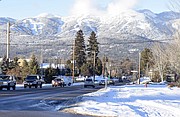Preserving views priority during 93 plan meeting
Preserving the view toward Big Mountain as it rises above Whitefish as seen from U.S. Highway 93 appears to be one of the top priorities for the future of the corridor in the city’s south gateway.
The view was one of the most pointed to positives of the route from those attending a public workshop earlier this month, and also maintaining the view even as development occurs was one of the higher ranking priorities for the future of the corridor.
The city of Whitefish recently hosted a workshop to gather input as a committee works to craft a corridor plan for Highway 93 South.
About 75 people attended the meeting at the Hampton Inn & Suites to help guide the vision for the corridor.
John Middleton, chair of the Highway 93 South Corridor Plan Steering Committee, said attendees would be asked to imagine what the corridor could be as it gets developed in the next 10 to 20 years.
“This visioning will ultimately help set the goals and objectives that will provide the framework for what will ultimately become the plan,” he said.
The plan is expected to focus on Highway 93 South from Sixth Street to Blanchard Lake Road south of Montana 40. The corridor is primarily zoned for highway commercial use with some adjacent residential land uses.
Dave Taylor, Planning and Building Director, likens a corridor plan to a set of blueprints for the construction of a house.
“We want to identify the issues and figure out where to go in the future,” he said of the plan.
The plan will ultimately go before the Planning Board and City Council for a vote.
Creating a corridor plan for 93 has been a high-priority item since the city adopted its master plan in 2007.
The committee is proposing for the purposes of the plan that the corridor be split into three areas — segment A is from Sixth Street to the Whitefish River, segment B is from the river to the Highway 93 and Montana 40 intersection at the city limits and segment C runs from Montana 40 to Blanchard Lake Road.
In groups, attendees were asked to look at several aerial maps of the corridor then identify the positives or important features they’d like to see preserved, what the vision or feel should be and how growth should be directed, in each section of the corridor.
Middleton noted that protecting the views along the corridor seemed to be a common thread. He summarized some of the comments, noting those who said the corridor is the front door of Whitefish and strip development there should be discouraged.
“If there is land suitable for multi-use developments, retail and multi-family or pocket neighborhoods,” he said. “How do we do [protect the view] and balance the housing needs of the community? Pocket neighborhoods are one solution — people living in those micro-communities will use those businesses near where they live. What is it that we want people to see as you’re driving north. Do you want to see something that reflects our community.”
In addition to the view, many folks said they enjoy trails and paths in the corridor while improving connectivity for pedestrians and bicyclists was also a priority. Many wanted to preserve views of the Whitefish River, and maintain and improve landscaping directly along the highway.
Traffic congestion concerns were brought forward pertaining to all sections of the corridor. Some suggested lowering the speed limits, while others suggested eliminating the center turn lane on the highway, and others wanted to add medians and a bike path on the road.
For the section north of the Whitefish River, many liked the mix of residential and business located inside old homes. Some suggested that the smaller homes lining the highway in that area be retained to keep the “small town” and welcoming feel as drivers get closer to downtown.
Several said they’d like to see more parks in the corridor that could serve both residents and visitors who might be staying at hotels along the highway. Others suggested retaining open space and wildlife corridors.
A few said they’d like to discourage more development south of Montana 40 outside city limits.
In the final exercise of the evening, attendees were asked to place dots on areas currently undeveloped in the corridor from the river to Montana 40 where they would prefer to see new housing located. The housing could be anything from single-family to mixed-use including commercial and residential, to multi-family housing.
Most of the dots ended up spread throughout the undeveloped areas of town. However, many of groups placed a larger portion of their dots on the former North Valley Hospital site and the adjacent former Greenwood Trailer Park.
Mayor John Muhlfeld opened the meeting noting how other corridor and similar plans in the city have helped to improve and guide development throughout town.
“We’re hopeful that this visioning session will help us put together a plan that will reflect the vision of the residents and the businesses of Whitefish,” he said. “I’ve always felt very strongly that economically the downtown and the highway have a synergistic model — they depend on each other and we’re united as an economic model.”
Comments concerning corridor plan can be mailed to: Hilary Lindh, City of Whitefish, Planning & Building, P.O. Box 158, Whitefish, MT 59937. Comments may also be submitted by email to hlindh@cityofwhitefish.org.
The city has also launched a survey to get input on the plan. For more information, visit http://www.cityofwhitefish.org/planning-and-building/long-range-plans.php.



